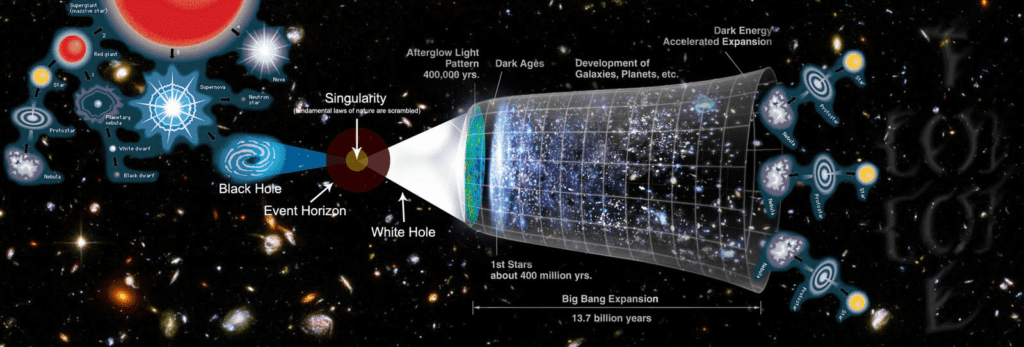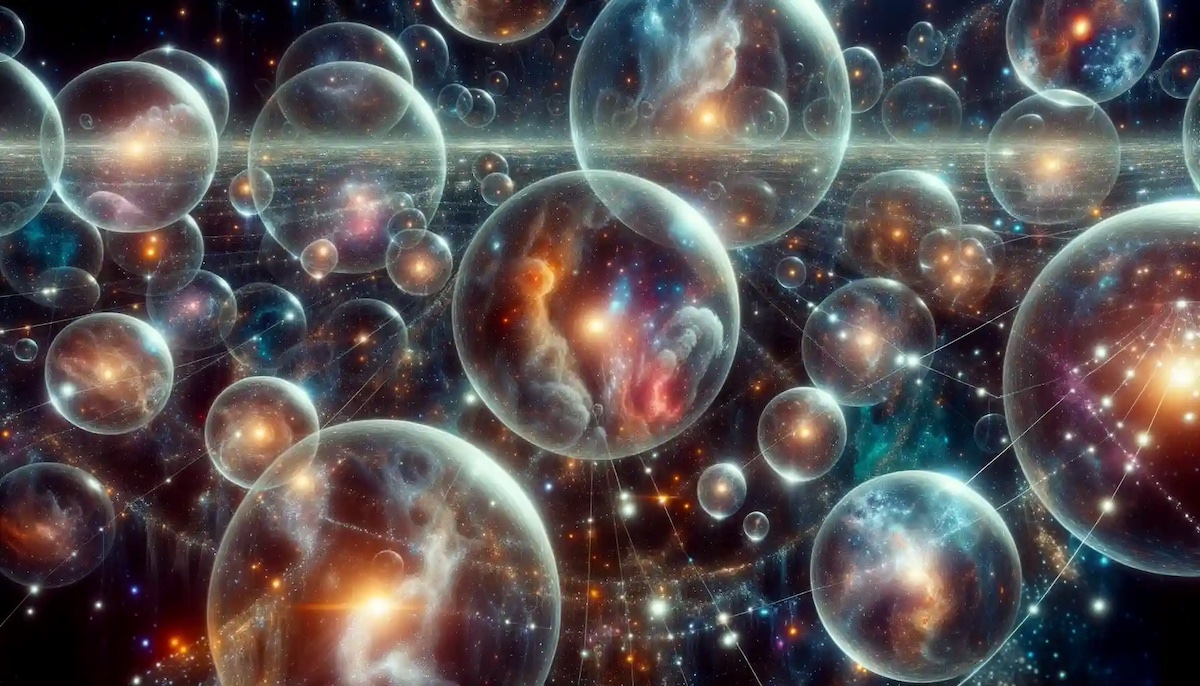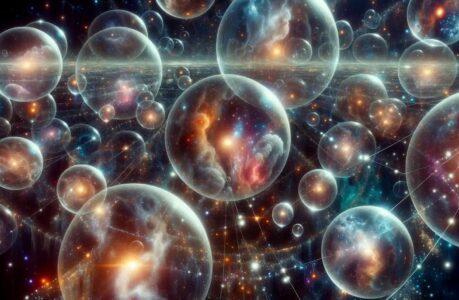Is Our Universe Just One Among Many? A Journey into the Multiverse
In the boundless cosmos, humans have always been drawn to the profound question: “Are there other universes or dimensions?” This inquiry transcends mere curiosity; it delves into the very fabric of reality itself. In this exploration, we embark on a quest to understand the tantalizing possibility of parallel universes, alternate dimensions, and the enigmatic multiverse.
Unveiling the Multiverse: A Cosmic Exploration
The universe we know is a wondrous tapestry of galaxies, stars, and planets, bound by the laws of physics. Yet, could our cosmos be just one fragment of a vast, interconnected multiverse, where countless other realms exist in parallel to our own? The notion of a multiverse challenges our conventional understanding of reality and sparks a captivating journey into the unknown.

The concept of a multiverse arises from several intriguing aspects of modern physics, as it attempts to address some of the fundamental questions and anomalies that a singular universe explanation struggles to resolve. Here are some key reasons why a multiverse explanation is considered in the realm of physics:
- Theoretical Incompleteness: Our current understanding of physics, particularly in the realms of quantum mechanics and cosmology, faces limitations and unresolved questions. Many physical phenomena can be explained only partially within the framework of a single universe. The multiverse offers a way to potentially address these gaps and provide a more comprehensive theoretical framework.
- Quantum Mechanics and Wavefunction Collapse: In quantum mechanics, the famous Schrödinger’s cat experiment and the concept of superposition suggest that particles and systems can exist in multiple states simultaneously until they are observed. This raises questions about why we observe only one outcome in our universe. The Many-Worlds Interpretation (MWI) of quantum mechanics proposes that all possible outcomes occur in separate branches of reality, leading to a multiverse of parallel universes, each representing a different outcome.
- Fine-Tuning Problem: The physical constants and parameters of our universe appear to be finely tuned to allow for the existence of complex structures, including galaxies, stars, and life itself. The remarkable fine-tuning of these constants raises the question of why our universe possesses such precise values. Some proponents of the multiverse argue that if there are multiple universes with different constants, it increases the chances of at least one universe having the right conditions for life.
- String Theory and the Landscape: String theory, a leading candidate for a unified theory of fundamental forces, suggests that our universe may have extra dimensions and that there are a vast number of possible configurations of these dimensions. The different configurations could correspond to different universes with varying physical laws and constants. This landscape of possibilities within string theory leads to the idea of a multiverse.
- Cosmic Microwave Background Anomalies: The cosmic microwave background (CMB) radiation is a remnant of the Big Bang and provides crucial insights into the early universe. Some anomalies in the CMB, such as temperature variations or unusual patterns, have led scientists to consider the possibility that these irregularities may be influenced by neighboring universes or dimensions interacting with our own.
- Dark Matter and Dark Energy: The nature of dark matter and dark energy, which collectively make up the majority of the universe’s content, remains mysterious. The existence of other universes with different properties could offer potential explanations for the behavior of these enigmatic cosmic components.
- Solving the Fermi Paradox: The Fermi Paradox raises the question of why we have not detected signs of extraterrestrial civilizations, given the vast number of potentially habitable planets in our galaxy alone. The multiverse hypothesis provides a potential answer: if intelligent life is relatively rare in our universe but more common in others, the absence of contact with extraterrestrial civilizations in our universe may be explained.
While the multiverse concept is still highly speculative and lacks direct empirical evidence, it is an intriguing and mathematically consistent idea that some physicists explore as a means to address these fundamental questions and anomalies within the framework of modern physics. The pursuit of understanding the multiverse is ongoing, with ongoing research and experiments aimed at uncovering potential evidence to support or refute this concept.
The Quantum Multiverse: A Subatomic Wonderland
Our exploration begins at the quantum level, where the fundamental rules of reality seem to operate differently. In the realm of quantum mechanics, the concept of a multiverse arises from the infamous Schrödinger’s cat experiment. This experiment suggests that all possible outcomes occur in separate branches of reality, creating a multitude of universes, each representing a different outcome.
In simpler terms, imagine a cat enclosed in a sealed box with a radioactive atom. According to quantum theory, until we open the box and observe the cat, it exists in a superposition of both alive and dead states. In the multiverse, each possibility plays out in a separate universe. This phenomenon challenges our intuitive understanding of reality, where things are either one way or another.
The Many-Worlds Interpretation: Infinite Choices, Infinite Universes
One of the most intriguing theories within the multiverse framework is the Many-Worlds Interpretation (MWI). Proposed by physicist Hugh Everett III in the 1950s, MWI posits that every quantum event spawns multiple universes, each corresponding to a different outcome. Imagine a reality where every choice you make splits the universe into multiple branches, giving birth to a limitless array of parallel worlds.

For example, if you were faced with a decision as simple as whether to have coffee or tea, MWI suggests that in one universe, you choose coffee, and in another, you choose tea. The implications of this theory are profound, as it implies that every possible scenario unfolds in its separate universe, creating an intricate web of parallel realities.
Beyond Quantum Realms: The Multiverse Hypothesis
While the quantum multiverse captivates the imagination, there are other multiverse hypotheses that extend beyond the quantum realm. One such concept is the “Bubble Multiverse.” According to this theory, our universe exists within a vast cosmic bubble, and other bubbles containing different universes populate a grand cosmic foam. These universes may have entirely different physical constants and laws of nature.
Imagine our universe as a soap bubble within a vast sea of other bubbles, each with its unique properties. Some may have different laws of physics, fundamental particles, and even dimensions. While this concept remains speculative, it offers a compelling perspective on the potential diversity of the multiverse.
Are We Living in a Simulated Universe?
As we delve deeper into the multiverse, another intriguing question emerges: Could our reality be nothing more than a simulation? This notion, popularized by philosopher Nick Bostrom, suggests that an advanced civilization may have created a simulated universe, and we are merely characters in their cosmic experiment.
The Simulation Hypothesis: A Matrix of Possibilities
The Simulation Hypothesis proposes that future civilizations with advanced technology could create simulations indistinguishable from reality. If this is the case, then we might be living in a meticulously crafted virtual world, where the laws of physics are programmed by an external intelligence.
Imagine a scenario where our universe is akin to a highly advanced computer program, designed and run by an advanced civilization. In this simulated reality, everything we experience, from the laws of physics to the motion of celestial bodies, is a product of sophisticated programming. This concept challenges our perception of reality and raises profound questions about the nature of existence.
Reality as Code: Seeking Evidence for Simulation
To investigate the possibility of a simulated universe, scientists are conducting experiments and observations that seek to detect glitches or anomalies in our reality. They explore the fundamental nature of the cosmos, looking for signs that our universe’s programming may not be as seamless as it appears.
For instance, researchers are examining the fabric of space-time itself, searching for irregularities or patterns that might suggest underlying code. They are also exploring quantum phenomena and cosmic phenomena for any hints of artificial manipulation.
Multiverse and String Theory: A Harmonious Framework
In the quest to understand the multiverse, string theory emerges as a harmonious and mathematically elegant framework. This theoretical framework unifies the fundamental forces of nature and offers a compelling perspective on the existence of multiple universes.
Strings and Dimensions: The Building Blocks of Reality
String theory posits that at the tiniest scales, the universe is not composed of point particles but rather tiny, vibrating strings. These strings resonate at different frequencies, giving rise to the particles and forces that make up our universe. String theory also suggests the existence of extra dimensions beyond the familiar three of space and one of time.
Imagine the fundamental building blocks of the universe as tiny, vibrating strings. These strings can vibrate in different patterns, giving rise to the various particles and forces in the universe. Moreover, string theory proposes that our universe may have more than the familiar three dimensions of space and one dimension of time. These extra dimensions could be compactified or hidden from our perception.
The Multiverse in String Theory: A Cosmic Landscape
Within string theory, the concept of a multiverse arises from the existence of a vast “landscape” of possible solutions. These solutions represent different configurations of the extra dimensions and the vibrational patterns of strings. Each configuration corresponds to a different universe with its unique set of physical laws and constants.
Imagine a cosmic landscape, where each hill, valley, and peak represents a different configuration of string theory. As we explore this landscape, we encounter universes with varying physical properties, such as different particle masses or gravitational forces. This vast multiverse of possibilities challenges our understanding of the uniqueness of our own universe.
Parallel Universes in Popular Culture: Science Fiction vs. Reality
The idea of parallel universes and alternate dimensions has long captivated the human imagination. In the realm of science fiction, authors and filmmakers have explored these concepts, offering us tantalizing glimpses into the possibilities of parallel worlds.
The Multiverse in Pop Culture: Fictional Realities
Science fiction novels like H.G. Wells’ “The Time Machine” and Philip K. Dick’s “The Man in the High Castle” have taken readers on journeys through alternate realities. These stories provoke thought about the implications of different choices and circumstances on the course of history.
In H.G. Wells’ “The Time Machine,” readers are transported to a future where humanity has evolved into two distinct species, the Eloi and the Morlocks. This divergence in evolution raises questions about the potential consequences of our choices and actions on the trajectory of our species.
From Marvel to DC: Parallel Universes in Comics
Comic book enthusiasts are no strangers to parallel universes. Universes like the Marvel Multiverse and the DC Multiverse feature alternate versions of beloved superheroes and villains, creating complex and interconnected storylines that span across dimensions.
Imagine a world where Spider-Man is not Peter Parker but Gwen Stacy, or where Superman’s origin story unfolds in a different way. These alternate realities offer endless storytelling possibilities and captivate readers with their exploration of the multiverse concept.
The Search for Evidence: Observations and Experiments
While the concept of the multiverse is undeniably captivating, scientific inquiry demands empirical evidence. Scientists and researchers are actively pursuing experiments and observations that could provide clues to the existence of other universes or dimensions.
Cosmic Microwave Background: Echoes of Other Realms
One avenue of investigation lies in the cosmic microwave background radiation, the afterglow of the Big Bang. Some scientists believe that anomalies or patterns in this radiation could be indicative of other universes brushing against our own.
The cosmic microwave background radiation is like a snapshot of the early universe, capturing its temperature and structure. Analyzing this radiation may reveal subtle irregularities or patterns that hint at the influence of neighboring universes or dimensions.
The Large Hadron Collider: Probing the Multiverse
At CERN’s Large Hadron Collider (LHC), scientists are smashing particles at incredible energies to unlock the secrets of the universe. Some of these experiments aim to detect the existence of extra dimensions or particles that could provide evidence for the multiverse.
Imagine a colossal underground ring where particles are accelerated to nearly the speed of light before colliding. Within this high-energy environment, scientists seek to recreate conditions that existed shortly after the Big Bang, hoping to uncover clues about the fundamental nature of our universe and the possible existence of parallel dimensions.
Multiverse and the Fermi Paradox: A Cosmic Puzzle
The Fermi Paradox raises an intriguing question: If there are so many potential universes and civilizations in the multiverse, why haven’t we encountered extraterrestrial life? This paradox continues to baffle scientists and adds an extra layer of complexity to the search for other dimensions.
Consider the vastness of the multiverse, with its myriad of potential civilizations and life forms. If the multiverse hypothesis is correct, then one would expect that intelligent, technologically advanced civilizations should be abundant. However, our lack of contact with extraterrestrial civilizations remains a profound mystery, leading to a perplexing cosmic conundrum.
Beyond the Multiverse: Philosophical and Ethical Implications
The exploration of other universes and dimensions not only challenges our understanding of the cosmos but also raises profound philosophical and ethical questions. As we venture further into the unknown, we must consider the implications of our discoveries.
Ethical Considerations: Playing with the Multiverse
The power to manipulate or access other dimensions could have significant ethical ramifications. Should we ever possess the technology to open gateways to other realms, we must grapple with the responsibility of our actions and their impact on the multiverse.
Imagine a scenario where we gain the ability to access parallel universes or alternate dimensions. This newfound power could lead to ethical dilemmas concerning the potential consequences of our actions on other realms. We must carefully consider the moral implications of such discoveries and their impact on the integrity of the multiverse.
The Quest for Meaning: Multiverse and Existential Philosophy
The existence of other universes prompts questions about the nature of reality and our place within it. Existential philosophers ponder how the multiverse concept influences our understanding of identity, purpose, and the human condition.
Contemplate the idea that our existence is not confined to a single universe but is part of a vast multiverse. This perspective challenges conventional notions of identity and purpose, inviting us to explore the profound philosophical implications of our place within the cosmic tapestry.
Multiverse or Singular Universe: The Ongoing Debate
In the grand cosmic tapestry, the concept of the multiverse challenges our perception of reality and opens a Pandora’s box of intriguing possibilities. Whether through quantum mechanics, string theory, or philosophical musings, the exploration of other dimensions and parallel universes captivates the human spirit, driving us to unlock the mysteries of the cosmos.
As we continue our cosmic exploration, one thing is clear: the quest to answer the age-old question, “Are there other universes or dimensions?” will persist as a beacon of scientific and philosophical curiosity, guiding us toward a deeper understanding of the universe and our place within it. The multiverse, with its enigmatic allure, beckons us to explore, discover, and expand our horizons beyond the boundaries of our known reality. In the end, it is not just a question of science; it is a journey of the human spirit, pushing the boundaries of what we thought possible.

